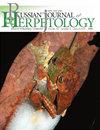秘鲁Cerros de Amotape国家公园(Tumbes, Peru)两种Teiidae物种的资源分配(蜥蜴:Teiidae)
IF 0.9
4区 生物学
Q3 ZOOLOGY
引用次数: 0
摘要
蜥蜴利用不同的生态位三个维度:空间、时间和营养生态位来减少或避免竞争。在2006年旱季,我们比较了9月巨蜥(Holcosus septemlineatus)和龙爪龙(Medopheos edracanthus)两种蜥蜴的资源分配情况。在秘鲁Tumbes的Cerros de Amotape国家公园中,九月天巨翅与埃德拉卡索巨翅在空间生态位(Φjk = 0.81)和时间生态位(Φjk = 0.88)上呈现高度重叠,而在营养生态位上呈现中度重叠(Φjk = 0.52)。两种蜥蜴的活动模式(08:00 ~ 16:00)和体温(35.9°和36.6°C)相似,但它们所面临的热环境不同,所选择的微生境也不同。九月天蛾选择了更多森林覆盖的微生境,而夜蛾选择了更多阳光照射的微生境。这两个物种的饮食相似(蟋蟀、蜘蛛、白蚁和昆虫幼虫)。显然,营养生态位指数值可能与较高的猎物丰度有关,与微生境利用与日照程度有关的微小差异有关。这应该作为Cerros de Amotape国家公园这两个物种之间的资源分配策略。本文章由计算机程序翻译,如有差异,请以英文原文为准。
Resource Partitioning Between Two Teiid Species (Sauria: Teiidae) in Cerros de Amotape National Park (Tumbes, Peru)
Saurians use differentially three dimensions of the ecological niche: spatial, temporal, and trophic niche to minimize or avoid competition. During dry season of 2006, we compared resource partitioning in two saurian species, Holcosus septemlineatus and Medopheos edracanthus. In Cerros de Amotape National Park (Tumbes, Peru), Holcosus septemlineatus and M. edracanthus presented high overlap in spatial (Φjk = 0.81) and temporal niches (Φjk = 0.88), while trophic niche overlap was intermediate (Φjk = 0.52). Both lizard species showed similar activity patterns (08:00 – 16:00) and body temperatures (35.9° and 36.6°C, respectively), although they faced different thermal environments, and selected different microhabitats. Holcosus septemlineatus selected more forest-covered microhabitats, while M. edracanthus used more sun-exposed microhabitats. Both species consumed a similar diet (crickets, spiders, termits and insect larvae). Apparently, the trophic niche index value could be associated with a high prey abundance and to slight differences in microhabitat use related to sun-exposure degree. This should be used as a resource partitioning strategy between these two species at Cerros de Amotape National Park.
求助全文
通过发布文献求助,成功后即可免费获取论文全文。
去求助
来源期刊

Russian Journal of Herpetology
ZOOLOGY-
CiteScore
1.70
自引率
0.00%
发文量
29
期刊介绍:
Russian Journal of Herpetology is an international multi-disciplinary journal devoted to herpetology. Russian Journal of Herpetology accepts original papers on ecology, behavior, conservation, systematics, evolutionary morphology, paleontology, physiology, cytology and genetics of amphibians and reptiles.
Types of Contributions:
-original papers
-invited or contributed reviews on specific topics
-short communications on topics of immediate interest, new methods and ideas in progress
-notices of meetings, symposia, and short courses
-book reviews
 求助内容:
求助内容: 应助结果提醒方式:
应助结果提醒方式:


